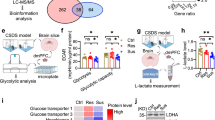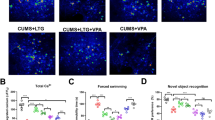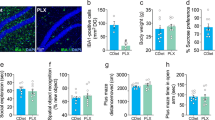Abstract
Growing evidence indicates that glia pathology and amino-acid neurotransmitter system abnormalities contribute to the pathophysiology and possibly the pathogenesis of major depressive disorder. This study investigates changes in glial function occurring in the rat prefrontal cortex (PFC) after chronic unpredictable stress (CUS), a rodent model of depression. Furthermore, we analyzed the effects of riluzole, a Food and Drug Administration-approved drug for the treatment of amyotrophic laterosclerosis, known to modulate glutamate release and facilate glutamate uptake, on CUS-induced glial dysfunction and depressive-like behaviors. We provide the first experimental evidence that chronic stress impairs cortical glial function. Animals exposed to CUS and showing behavioral deficits in sucrose preference and active avoidance exhibited significant decreases in 13C-acetate metabolism reflecting glial cell metabolism, and glial fibrillary associated protein (GFAP) mRNA expression in the PFC. The cellular, metabolic and behavioral alterations induced by CUS were reversed and/or blocked by chronic treatment with the glutamate-modulating drug riluzole. The beneficial effects of riluzole on CUS-induced anhedonia and helplessness demonstrate the antidepressant action of riluzole in rodents. Riluzole treatment also reversed CUS-induced reductions in glial metabolism and GFAP mRNA expression. Our results are consistent with recent open-label clinical trials showing the drug's effect in mood and anxiety disorders. This study provides further validation of hypothesis that glial dysfunction and disrupted amino-acid neurotransmission contribute to the pathophysiology of depression and that modulation of glutamate metabolism, uptake and/or release represent viable targets for antidepressant drug development.
This is a preview of subscription content, access via your institution
Access options
Subscribe to this journal
Receive 12 print issues and online access
$259.00 per year
only $21.58 per issue
Buy this article
- Purchase on SpringerLink
- Instant access to full article PDF
Prices may be subject to local taxes which are calculated during checkout





Similar content being viewed by others
References
Schildkaut JJ . The catacholamine hypothesis of affective disorders: a review of supporting evidence. Am J Psychiatry 1965; 122: 509–522.
Rush AJ, Trivedi MH, Wisniewski SR, Nierenberg AA, Stewart JW, Warden D et al. Acute and longer-term outcomes in depressed outpatients requiring one or several treatment steps: a STAR*D report. Am J Psychiatry 2006; 163: 1905–1917.
Rajkowska G, Miguel-Hidalgo JJ . Gliogenesis and glial pathology in depression. CNS Neurol Disord Drug Targets 2007; 6: 219–233.
Cotter D, Mackay D, Chana G, Beasley C, Landau S, Everall IP . Reduced neuronal size and glial cell density in area 9 of the dorsolateral prefrontal cortex in subjects with major depressive disorder. Cerebral Cortex 2002; 12: 386–394.
Cotter D, Mackay D, Landau S, Kerwin R, Everall I . Reduced glial cell density and neuronal size in the anterior cingulate cortex in major depressive disorder. Arch Gen Psychiatry 2001; 58: 545–553.
Ongur D, Drevets WC, Price JL . Glial reduction in the subgenual prefrontal cortex in mood disorders. Proc Natl Acad Sci USA 1998; 95: 13290–13295.
Uranova NA, Vostrikov VM, Orlovskaya DD, Rachmanova VI . Oligodendroglial density in the prefrontal cortex in schizophrenia and mood disorders: a study from the Stanley Neuropathology Consortium. Schizophr Res 2004; 67: 269–275.
Choudary PV, Molnar M, Evans SJ, Tomita H, Li JZ, Vawter MP et al. Altered cortical glutamatergic and GABAergic signal transmission with glial involvement in depression. Proc Natl Acad Sci USA 2005; 102: 15653–15658. E-pub 17 October 2005.
Si X, Miguel-Hidalgo JJ, O'Dwyer G, Stockmeier CA, Rajkowska G . Age-dependent reductions in the level of glial fibrillary acidic protein in the prefrontal cortex in major depression. Neuropsychopharmacology 2004; 29: 2088–2096.
Czeh B, Simon M, Schmelting B, Hiemke C, Fuchs E . Astroglial plasticity in the hippocampus is affected by chronic psychosocial stress and concomitant fluoxetine treatment. Neuropsychopharmacology 2006; 31: 1616–1626.
Czeh B, Muller-Keuker JI, Rygula R, Abumaria N, Hiemke C, Domenici E et al. Chronic social stress inhibits cell proliferation in the adult medial prefrontal cortex: hemispheric asymmetry and reversal by fluoxetine treatment. Neuropsychopharmacology 2007; 32: 1490–1503.
Banasr M, Valentine GW, Li XY, Gourley SL, Taylor JR, Duman RS . Chronic unpredictable stress decreases cell proliferation in the cerebral cortex of the adult rat. Biol Psychiatry 2007; 62: 496–504.
Banasr M, Duman RS . Regulation of neurogenesis and gliogenesis by stress and antidepressant treatment. CNS Neurol Disord Drug Targets 2007; 6: 311–320.
Manji HK, Quiroz JA, Sporn J, Payne JL, Denicoff K, A Gray N et al. Enhancing neuronal plasticity and cellular resilience to develop novel, improved therapeutics for difficult-to-treat depression. Biol Psychiatry 2003; 53: 707–742.
McEwen BS, Magarinos AM . Stress effects on morphology and function of the hippocampus. Ann NY Acad Sci 1997; 821: 271–284.
Sapolsky RM . The possibility of neurotoxicity in the hippocampus in major depression: a primer on neuron death. Biol Psychiatry 2000; 48: 755–765.
Kugaya A, Sanacora G . Beyond monoamines: glutamatergic function in mood disorders. CNS Spectr 2005; 10: 808–819.
Hertz L, Dringen R, Schousboe A, Robinson SR . Astrocytes: glutamate producers for neurons. J Neurosci Res 1999; 57: 417–428.
Schousboe A, Waagepetersen HS . Glial modulation of GABAergic and glutamatergic neurotransmission. Curr Top Med Chem 2006; 6: 929–934.
Beart PM, O'Shea RD . Transporters for L-glutamate: an update on their molecular pharmacology and pathological involvement. Br J Pharmacol 2007; 150: 5–17.
Lebon V, Petersen KF, Cline GW, Shen J, Mason GF, Dufour S et al. Astroglial contribution to brain energy metabolism in humans revealed by 13C nuclear magnetic resonance spectroscopy: elucidation of the dominant pathway for neurotransmitter glutamate repletion and measurement of astrocytic oxidative metabolism. J Neurosci 2002; 22: 1523–1531.
Soriano FX, Hardingham GE . Compartmentalized NMDA receptor signalling to survival and death. J Physiol 2007; 584: 381–387.
Hardingham GE . Pro-survival signalling from the NMDA receptor. Biochem Soc Trans 2006; 34: 936–938.
Zarate Jr CA, Singh JB, Carlson PJ, Brutsche NE, Ameli R, Luckenbaugh DA et al. A randomized trial of an N-methyl-D-aspartate antagonist in treatment-resistant major depression. Arch Gen Psychiatry 2006; 63: 856–864.
Rothstein JD, Patel S, Regan MR, Haenggeli C, Huang YH, Bergles DE et al. Beta-lactam antibiotics offer neuroprotection by increasing glutamate transporter expression. Nature 2005; 433: 73–77.
Mineur YS, Picciotto MR, Sanacora G . Antidepressant-like effects of ceftriaxone in male C57BL/6J mice. Biol Psychiatry 2007; 61: 250–252.
Azbill RD, Mu X, Springer JE . Riluzole increases high-affinity glutamate uptake in rat spinal cord synaptosomes. Brain Res 2000; 871: 175–180.
Frizzo ME, Dall'Onder LP, Dalcin KB, Souza DO . Riluzole enhances glutamate uptake in rat astrocyte cultures. Cell Mol Neurobiol 2004; 24: 123–128.
Fumagalli E, Funicello M, Rauen T, Gobbi M, Mennini T . Riluzole enhances the activity of glutamate transporters GLAST, GLT1 and EAAC1. Eur J Pharmacol 2008; 578: 171–176.
Sung B, Lim G, Mao J . Altered expression and uptake activity of spinal glutamate transporters after nerve injury contribute to the pathogenesis of neuropathic pain in rats. J Neurosci 2003; 23: 2899–2910.
Pittenger C, Coric V, Banasr M, Bloch M, Krystal JH, Sanacora G . Riluzole in the treatment of mood and anxiety disorders. CNS Drugs 2008; 22: 761–786.
Risterucci C, Coccurello R, Banasr M, Stutzmann JM, Amalric M, Nieoullon A . The metabotropic glutamate receptor subtype 5 antagonist MPEP and the Na(+) channel blocker riluzole show different neuroprotective profiles in reversing behavioral deficits induced by excitotoxic prefrontal cortex lesions. Neuroscience 2006; 137: 211–220.
Willner P . Chronic mild stress (CMS) revisited: consistency and behavioural–neurobiological concordance in the effects of CMS. Neuropsychobiology 2005; 52: 90–110.
Newton SS, Girgenti MJ, Collier EF, Duman RS . Electroconvulsive seizure increases adult hippocampal angiogenesis in rats. Eur J Neurosci 2006; 24: 819–828.
Chowdhury GM, Gupta M, Gibson KM, Patel AB, Behar KL . Altered cerebral glucose and acetate metabolism in succinic semialdehyde dehydrogenase-deficient mice: evidence for glial dysfunction and reduced glutamate/glutamine cycling. J Neurochem 2007; 103: 2077–2091.
Chowdhury GM, Patel AB, Mason GF, Rothman DL, Behar KL . Glutamatergic and GABAergic neurotransmitter cycling and energy metabolism in rat cerebral cortex during postnatal development. J Cereb Blood Flow Metab 2007; 27: 1895–1907.
Murua VS, Gomez RA, Andrea ME, Molina VA . Shuttle-box deficits induced by chronic variable stress: reversal by imipramine administration. Pharmacol Biochem Behav 1991; 38: 125–130.
Waniewski RA, Martin DL . Astrocytes and synaptosomes transport and metabolize lactate and acetate differently. Neurochem Res 2004; 29: 209–217.
Moghaddam B, Jackson M . Effect of stress on prefrontal cortex function. Neurotox Res 2004; 6: 73–78.
Muller MB, Lucassen PJ, Yassouridis A, Hoogendijk WJ, Holsboer F, Swaab DF . Neither major depression nor glucocorticoid treatment affects the cellular integrity of the human hippocampus. Eur J Neurosci 2001; 14: 1603–1612.
Miguel-Hidalgo JJ, Baucom C, Dilley G, Overholser JC, Meltzer HY, Stockmeier CA et al. Glial fibrillary acidic protein immunoreactivity in the prefrontal cortex distinguishes younger from older adults in major depressive disorder. Biol Psychiatry 2000; 48: 861–873.
Hashimoto K, Sawa A, Iyo M . Increased levels of glutamate in brains from patients with mood disorders. Biol Psychiatry 2007; 62: 1310–1316.
Haydon PG, Carmignoto G . Astrocyte control of synaptic transmission and neurovascular coupling. Physiol Rev 2006; 86: 1009–1031.
Hughes EG, Maguire JL, McMinn MT, Scholz RE, Sutherland ML . Loss of glial fibrillary acidic protein results in decreased glutamate transport and inhibition of PKA-induced EAAT2 cell surface trafficking. Brain Res Mol Brain Res 2004; 124: 114–123.
Sibson NR, Dhankhar A, Mason GF, Behar KL, Rothman DL, Shulman RG . In vivo13C NMR measurements of cerebral glutamine synthesis as evidence for glutamate-glutamine cycling. Proc Natl Acad Sci USA 1997; 94: 2699–2704.
Yang CH, Huang CC, Hsu KS . Behavioral stress enhances hippocampal CA1 long-term depression through the blockade of the glutamate uptake. J Neurosci 2005; 25: 4288–4293.
Dagci T, Yilmaz O, Taskiran D, Peker G . Neuroprotective agents: is effective on toxicity in glial cells? Cell Mol Neurobiol 2007; 27: 171–177.
Rajkowska G, O'Dwyer G, Teleki Z, Stockmeier CA, Miguel-Hidalgo JJ . GABAergic neurons immunoreactive for calcium binding proteins are reduced in the prefrontal cortex in major depression. Neuropsychopharmacology 2007; 32: 471–482.
Radley JJ, Rocher AB, Miller M, Janssen WG, Liston C, Hof PR et al. Repeated stress induces dendritic spine loss in the rat medial prefrontal cortex. Cereb Cortex 2006; 16: 313–320.
Banasr M, Duman RS . Glial loss in the prefrontal cortex is sufficient to induce depressive-like behaviors. Biol Psychiatry. E-pub ahead of print; 22 July 2008.
Acknowledgements
We thank Dr Jane Taylor and Dr Angus Narin for the use of their locomotor activity apparatus and microwave fixation system. We also thank Richard Trinko and Xiaoxian Ma for their technical assistance with the acetate infusion studies, and Mathew Girgenti for his technical assistance with the in situ hybridization studies. This study was supported by NARSAD (2007 NARSAD Forster Bam Investigator GS), K02 (MH076222, GS), VA CT Research Enhancement Award Program (REAP) research center (GS and RSD), R01 (MH25642, RSD), R01 (MH45481, RSD), R01 (DK027121, KB). The content is solely the responsibility of the authors and does not necessarily represent the official views of the National Institutes of Health. We thank Drs James CK Lai, Fahmeed Hyder and Robin A de Graaf for helpful discussions and Dr Prajna P Siddiqui for performing the brain tissue extracts.
Author information
Authors and Affiliations
Corresponding author
Additional information
Author Contributions: Mounira Banasr was responsible for all animal treatments and behavioral analyses. She also contributed significantly to the study design and writing of the paper. Golam Chowdhury was responsible for conducting and analyzing the ex vivo 13C-NMR studies and contributed in the overall study design and preparation of the paper. Rose Twillinger and Dr Samuel Newton performed the in situ hybridization studies. Ronald S Duman contributed to design and analysis related to the behavioral and cellular components of the study, as well as the preparation of the paper. Kevin Behar contributed to design and analysis related to the NMR components of the study as well as the preparation of the paper. Gerard Sanacora provided the study's conception. He also coordinated all study activities and contributed significantly to the preparation of the paper.
Supplementary Information accompanies the paper on the Molecular Psychiatry website
Supplementary information
Rights and permissions
About this article
Cite this article
Banasr, M., Chowdhury, G., Terwilliger, R. et al. Glial pathology in an animal model of depression: reversal of stress-induced cellular, metabolic and behavioral deficits by the glutamate-modulating drug riluzole. Mol Psychiatry 15, 501–511 (2010). https://doi.org/10.1038/mp.2008.106
Received:
Revised:
Accepted:
Published:
Issue Date:
DOI: https://doi.org/10.1038/mp.2008.106



